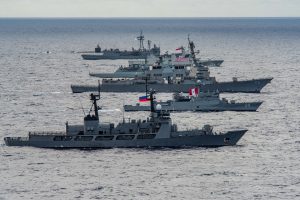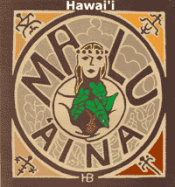The world’s largest international maritime exercise is scheduled to take place this summer. For now, it’s still on.

Navy ships assemble to form a multinational fleet for a photo exercise off the coast of Hawaii during the Rim of Pacific (RIMPAC) exercise July 26, 2018. Credit: U.S. Navy photo by Mass Communication Specialist 3rd Class Dylan M. Kinee/Released
This summer Hawaii’s skies will be filled with rockets, mortars, missiles, and drones. Warships, fighter jets, destroyers, and submarines will maneuver, and more than 25,000 military personnel will gather in Hawaii for the 27th Rim of the Pacific (RIMPAC) exercise, the world’s largest international maritime exercises, if all goes as planned.
But that’s one big “if.”
The spread of a novel coronavirus, termed SARS-CoV-2 and causing COVID-19 — now a global pandemic — is forcing an ever-increasing number of cancellations, travel bans, and sweeping, unprecedented disruptions.
School closures have affected over 776 million students. Major public gatherings, international conferences, and events large and small have been scrubbed. Entire countries have been put on lockdown.
In addition to health fears, disruptions and uncertainty have jolted the global economy as businesses shutter, financial markets plunge, and event planners from the South by Southwest festival (cancelled) to the Tokyo Olympics (not cancelled, yet) must consider scaling back, postponing, canceling, or risking that they may contribute to the worsening and prolongation of the pandemic.
For those planning this year’s RIMPAC exercises, expected to be held between late June and early August, the timing is tricky.
Since 1971, RIMPAC has been held in Hawaii and to a lesser degree southern California, where, in 2018, the commander of the U.S. Pacific Fleet welcomed military personnel from 24 other countries, including Australia, Canada, India, Israel, Japan, Malaysia, Mexico, Singapore, South Korea, Sri Lanka, and Vietnam.
In 2018, the U.K, France, and Germany, all currently experiencing a spike in COVID-19 cases, participated in RIMPAC . 2018 “observer nations” Turkey and Ecuador, and all other participants, have been invited back in 2020. China, which had been initially invited to RIMPAC 2018, was ultimately disinvited over tensions in the South China Sea.
A roster of participating countries for the 2020 iteration has not yet been publicly released.
The United States Naval Institute (USNI) news forum recently reported that Admiral John Aquilino, commander of the U.S. Pacific Fleet, said RIMPAC 2020 remained on track despite the spread of the coronavirus. This is in contrast to Europe, the Middle East, and Africa where joint military exercises have been cut short, scaled back, or cancelled in response to the coronavirus threat.
Aquilino described this year’s RIMPAC as “more complex and challenging” than in previous years. He also said that adequate precautions would be taken to ensure U.S. sailors and their families stay healthy, to limit the ability of the U.S. Navy to transmit the disease, and to maintain the Navy’s warfighting readiness.
Lt. Rochelle Rieger, a deputy public affairs officer with the U.S. Third Fleet, said that “the health, wellness, and safety of our collective RIMPAC 2020 team is a top priority,” adding that “planners and medical personnel will continue to closely monitor the global coronavirus situation and apply appropriate mitigations… to protect the force [and] prevent the spread of the virus to U.S. territories and partner nations.”
Meanwhile, several U.S. service members have been stricken with COVID-19 at bases within the United States. A marine dependent tested positive at Camp Lejeune, North Carolina, and at least nine cases involving U.S. Forces Korea, military dependents, or contractors in South Korea have been identified.
The U.S. Army has announced the suspension of travel to and from both South Korea and Italy for soldiers and dependents after the first U.S. Navy sailor in Italy tested positive for the virus. Meanwhile the Army’s top officer in Europe has self-quarantined out of fear he was exposed to the virus during a recent conference.
Last week, Secretary of Defense Mark Esper announced a 60-day ban on travel by troops or families. Beginning this week a “Stop Movement” order for members of the U.S. military will ban all domestic travel through May 11.
Global pandemic notwithstanding, RIMPAC brings a lot of money into Hawaii’s economy. Determining the exact economic impact of an event as large as RIMPAC has proven to be difficult but, according to Chamber of Commerce Hawaii president and CEO Sherry Menor-McNamara, the Navy Supply Systems Command and Hawaii Department of Business, Economic Development, and Tourism estimate RIMPAC generated $67 million for Hawaii businesses in 2014.
Add to that spending on fuel, supplies, and services, and the amount surpassed $100 million. Similar figures were reported for 2018 and “we should expect RIMPAC 2020 will have the same level of economic scale,” Menor-McNamara said.
“An additional concern is that RIMPAC is a significant training venue for the U.S. Navy and our partners and allies in the region,” Menor-McNamara said. “It fosters international cooperation and trust throughout the region while emphasizing humanitarian and disaster relief operations and support, as well as security and stability, which ultimately lead to prosperity and the free flow of commerce, which is especially important here in Hawaii.”
Honolulu Mayor Kirk Caldwell echoed that sentiment in a statement provided to The Diplomat. “The City and County of Honolulu always welcome military personnel from the continent and other locations around the world to the RIMPAC exercise on Oahu.”
Caldwell touted RIMPAC as promoting international collaboration, diversity, and mutual understanding, “security cooperation vital to the United States and our island community,” and a positive impact for the economy. Decisions on how to proceed with RIMPAC, the mayor said, would be made working closely with local military commands and the highest level of militaries of participating countries.
Ed Hawkins, executive director of Honolulu’s Office of Economic Development, said the large number of military personnel and families that RIMPAC draws provide a “deep economic push” through purchases of food, fuel, and other supplies, as well as leisure spending and the transient accommodation tax on Oahu.
“Right now we’re just following the guidelines of CDC,” Hawkins said. “Any large gatherings are discouraged. Major events like the Honolulu Festival — bringing in about 3,000 people to downtown Honolulu — was cancelled.”
Regarding conducting RIMPAC this summer, Hawkins speculated there could be restrictions on military personnel attending large group gatherings, but added, “As long as protocols are followed, I think there wouldn’t be concern about that.”
Professor Vivek Nerurkar, chair of the Department of Tropical Medicine, Medical Microbiology, and Pharmacology and director of the John A. Burns School of Medicine Biocontainment Facility at the University of Hawaii, believes there’s still time to observe global health developments before RIMPAC is scheduled to begin. “I suspect that things will look much different come six weeks from now,” Nerurkar said. “I think it’s just a game of waiting to see how bad it gets or how good it turns around.”
Nerurkar said he is more concerned about the threat posed by cruise ships in Hawaii than by military vessels.
But in Hawaii, which was a sovereign, independent kingdom until being overthrown with support from the U.S. military in 1893, some view RIMPAC as one form of ongoing exploitation and an unwelcome militarization of Hawaiian air, land, and sea.
Ann Wright, a retired U.S. Army colonel and diplomat who resigned in protest against the 2003 U.S. invasion of Iraq, called RIMPAC “provocative in normal times,” and said “to allow international military to come to Hawaii when U.S. military cannot travel domestically would be irresponsible.”
The office of Governor David Ige and Hawaii’s Department of Health did not respond to requests for comment.
From multinational military training and testing new weapons, promoting military technology along with international exchanges, developing interoperability and “validating command and control of multinational task groups,” to the tens of millions of dollars that flow in the wake of the battleships and submarines, RIMPAC’s impact is enormous.
But as the world battles a global pandemic that has infected over 179,700 and taken the lives of at least 7,100 people in 140 countries (and counting), the grim facts suggest RIMPAC planners need to take a long, hard look at what holding the exercise could mean for people in Hawaii, across the Asia-Pacific, and around the world. In the coronavirus, humanity faces an enemy that is bolstered by large gatherings and can’t be vanquished with bullets and bombs.
Jon Letman is a Hawaii-based independent journalist covering politics, people, and the environment in the Asia-Pacific region. He has written for Al Jazeera, Foreign Policy in Focus, Inter Press Service, and others.



